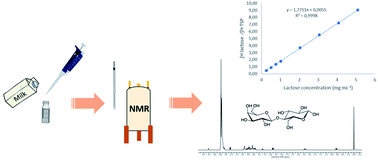Lactose quantification in bovine milk by nuclear magnetic resonance without deuterated solvent (No-D qNMR)
Abstract
Milk is a homogeneous mixture of substances such as lactose, proteins, and glycerides. Among carbohydrates, lactose is a disaccharide composed of glucose and galactose, and it is present in bovine milk at a level of 4.6%. According to resolution no. 135 of the National Health Surveillance Agency (ANVISA) from Brazil, dairy products labeled “lactose-free” must contain 1.0 mg mL−1 or less of this disaccharide. Thus, this work aims to develop and validate a method for quantifying the lactose content by quantitative nuclear magnetic resonance without the use of deuterated solvent (No-D qMNR). The validation of the developed method followed the norms provided by ANVISA resolution RDC no. 166, based on the figures of merit such as selectivity, linearity, the limit of detection (LOD) and quantification (LOQ), accuracy, precision, and robustness. The obtained results validated the method due to excellent linearity, demonstrated by the value of R > 0.990 and the homoscedasticity of the results, as well as precision, accuracy, and robustness values lower than 5%. Furthermore, LOD and LOQ values around 0.1345 mg mL−1 and 0.4076 mg mL−1, respectively, were obtained, which are lower than those required by legislation. The No-D qNMR technique was also able to quantify lactose content in commercial lactose-free milk.



 Please wait while we load your content...
Please wait while we load your content...